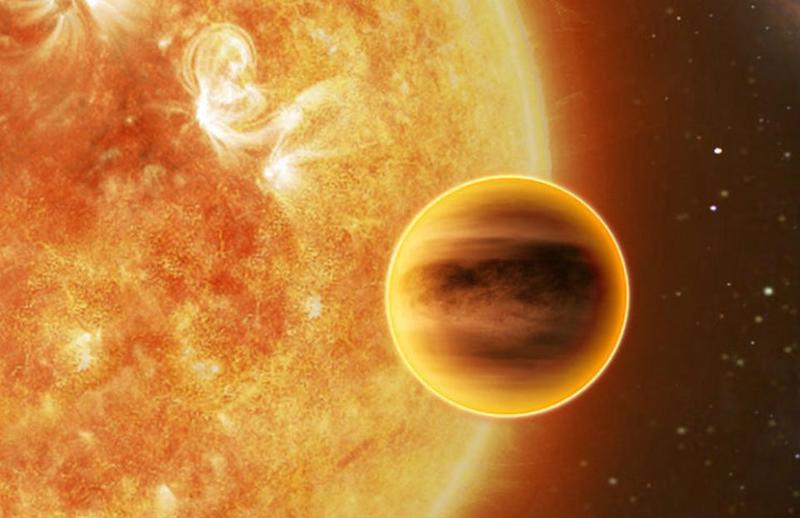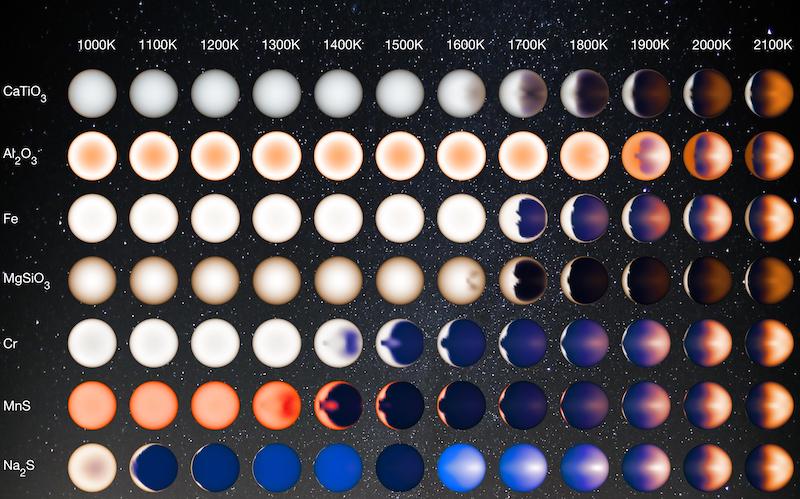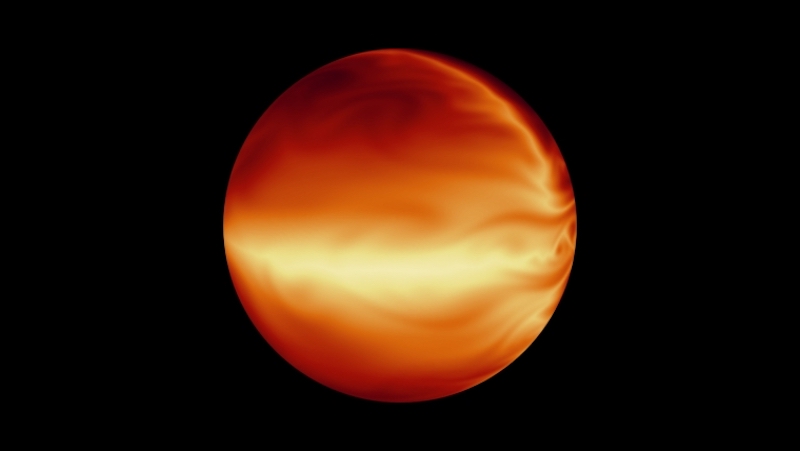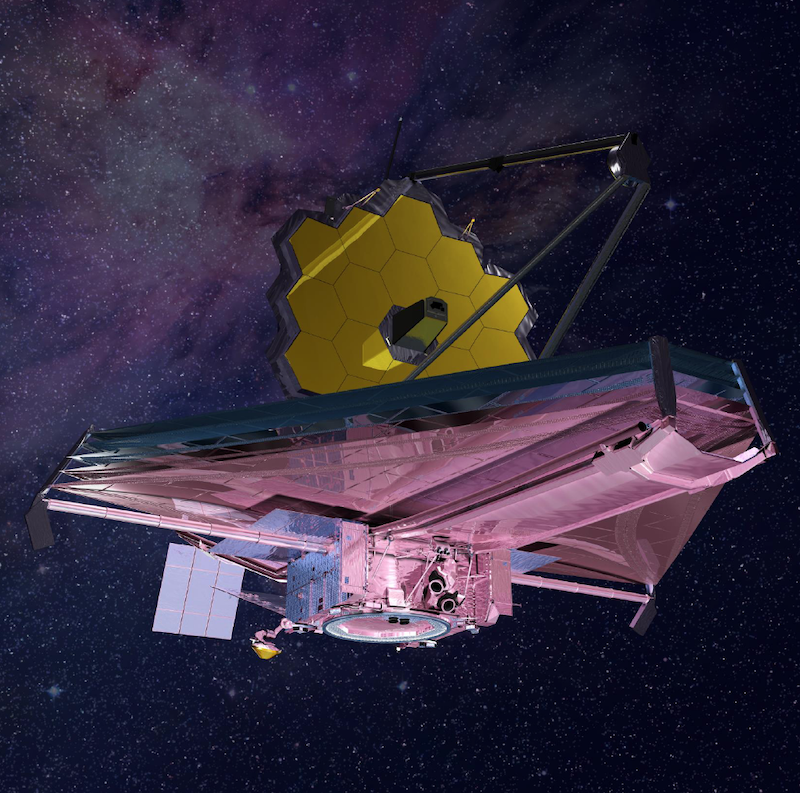
Field guide for hot Jupiters
This month (October 21, 2021), astronomers announced a new tool for scientists, to help in the study of what are called hot Jupiters. They’re calling it a “field guide” for hot Jupiters. Of the 4,000+ exoplanets known so far – planets orbiting distant stars in our Milky Way galaxy – several hundred are hot Jupiters. The new guide for scientists combines observations from the Hubble Space Telescope and theoretical models. It’s nothing you or I could hold in our hands, as we would a field guide for birds or stars. But, for those scientists who use it, it offers insights into planet formation in general. And it’s noteworthy as an early study of exoplanet atmospheres, a subject on the frontier of exoplanet research. The new study is called A unique hot Jupiter spectral sequence with evidence for compositional diversity.
The peer-reviewed journal Nature published the study on October 21. Astronomer Megan Mansfield at the University of Arizona led the research team.
What are hot Jupiters?
When you think of hot Jupiter exoplanets, you can think large masses and short orbital periods. These planets are thought to be physically similar to Jupiter, the largest planet in our solar system. Our own Jupiter contains more mass than all the other planets in our solar system combined. It’s more than 300 times more massive than Earth. A distant hot Jupiter – orbiting a star beyond our sun, in the Milky Way galaxy – might have somewhere between about a third of a Jupiter-mass and about a dozen Jupiter masses. If an object has more mass, temperatures and pressures at its core are high enough to spark deuterium fusion. Such an object is no longer called a planet, but a brown dwarf.
Hot Jupiters are also characterized by their short orbital periods around their stars. Our planet Jupiter is the fifth planet outward in our solar system. It’s beyond the orbit of Mars, and beyond the asteroid belt. Our Jupiter takes 12 Earth-years to orbit our sun. On the other hand, hot Jupiters are known with orbits as fast as 1.3 Earth-days! And they might range up over 100 Earth-days. So they’re close to their stars, and that’s why they’re hot!
The new study is the first to examine a broad population of hot Jupiters. Previous studies have tended to focus more on those most similar to our own Jupiter. Also, observations from the Hubble Space Telescope measured the emission spectra of these scorching worlds. And that’s another important point about these worlds. We can’t actually see them. When we look toward their stars, the planets are lost in the stars’ glare. Most hot Jupiters are found when they transit – cross in front of – their stars, causing a dip in the stars’ light. As Mansfield said:
These systems, these stars and their hot Jupiters, are too far away to resolve the individual star and its planet. All we can see is a point, the combined light source of the two.
So measuring spectra from hot Jupiters is a feat unto itself. And it’s an important tool for astronomers who want to study these worlds. How did they accomplish it? The researchers used a technique called secondary eclipsing – where the planet passes not in front of but behind its star – to “look” deeper into their atmospheres and learn more about their structure and chemical composition. In secondary eclipsing, astronomers make repeated observations of the planet at various spots along its orbit around its star. As Mansfield explained:
We basically measure the combined light coming from the star and its planet and compare that measurement with what we see when the planet is hidden behind its star. This allows us to subtract the star’s contribution and isolate the light emitted by the planet, even though we can’t see it directly.

Eclipse data provides clues about hot Jupiters
The researchers want to better understand the thermal structure of the atmospheres on hot Jupiters. To that end, secondary eclipsing provides that data, allowing the researchers to construct individual profiles of temperatures and pressures for each planet.
Additionally, near-infrared light, a type of infrared light, was also analyzed, which can reveal aborption features in the planets’ atmospheres. This study works something like fingerprint analysis, actually, since each atom or molecule has its own unique profile. Ultimately, by looking at various wavelengths, the researchers can determine the chemical makeup of the atmosphere of each planet. According to Mansfield:
In a way, we use molecules to scan through the atmospheres on these hot Jupiters. We can use the spectrum we observe to get information on what the atmosphere is made of, and we can also get information on what the structure of the atmosphere looks like.

Theoretical models
The analysis of the hot Jupiters isn’t limited to just the eclipse data, however. In addition, the researchers also used computer models of the physical processes that are thought to be occurring in the planets’ atmospheres. These were compared to the observational data. As it turned out, there was a close match. That success, overall, shows how previous theoretical models about the planets were correct.
So what were the results? The findings suggest that, for the most part, hot Jupiters are all pretty similar. Overall, they should have basically the same sets of molecules, such as water and carbon monoxide. They should also have smaller amounts of other molecules as well. The only significant differences would be varying relative amounts of the molecules. Water absorption features in the atmospheres were also found to vary slightly among hot Jupiters. Mansfield said:
Taken together, our results tell us there is a good chance we have the big picture items figured out that are happening in the chemistry of these planets. At the same time, each planet has its own chemical makeup, and that also influences what we see in our observations.
Exotic scorching worlds
In general, hot Jupiters may be similar to Jupiter in some ways, but they are also uniquely alien. We don’t have any giant planets in our solar system that orbit close to the sun. Yet, they seem to be quite common elsewhere in our galaxy. About one in 10 stars is estimated to have a hot Jupiter. Many have been discovered, although that is largely due to the fact that they are easier to detect than smaller rocky or gas planets. The hot Jupiters that we know about range in size from 1/3 that of Jupiter to 10 times as massive as Jupiter (known as super-Jupiters).

What makes hot Jupiters so different is that they orbit very close to their stars, typically closer than Mercury orbits our sun. In fact, a year on a hot Jupiter usually lasts only a few days or even just hours.
A guide for future observations
The guide will be particularly useful for studying hot Jupiters that are newly discovered in the years ahead. Also, the upcoming James Webb Space Telescope (JWST), due to launch on December 18, will be able to take a closer look at hot Jupiters than ever before. As Mansfield commented:
There is a lot that we still don’t know about how planets form in general, and one of the ways we try to understand how that could happen is by looking at the atmospheres of these hot Jupiters and figuring out how they got to be where they are. With the Hubble data, we can look at trends by studying the water absorption, but when we are talking about the composition of the atmosphere as a whole, there are many other important molecules you want to look at, such as carbon monoxide and carbon dioxide, and JWST will give us a chance to actually observe those as well.
The New Extension in Nançay Upgrading LOFAR (NenuFAR), located at the Nançay Radioastronomy Station in France, will also be taking a closer look at hot Jupiters. It will “see inside” them by studying their magnetic fields.

Implications for exoplanet science
As noted in the paper, the findings also have implications for exoplanet science overall:
Beyond testing our hypothesis, more precise compositional constraints on exoplanet atmospheres would inform our understanding of the formation and evolution processes that have produced the diverse planetary systems revealed over the last 25 years.
Bottom line: Astronomers have developed a new exoplanet field guide for hot Jupiters, giant hot planets that orbit very close to their stars. It greatly expands on previous studies, combining observations from the Hubble Space Telescope with theoretical models.
Source: A unique hot Jupiter spectral sequence with evidence for compositional diversity
Source (preprint): A unique hot Jupiter spectral sequence with evidence for compositional diversity
The post A new field guide for hot Jupiters first appeared on EarthSky.
0 Commentaires